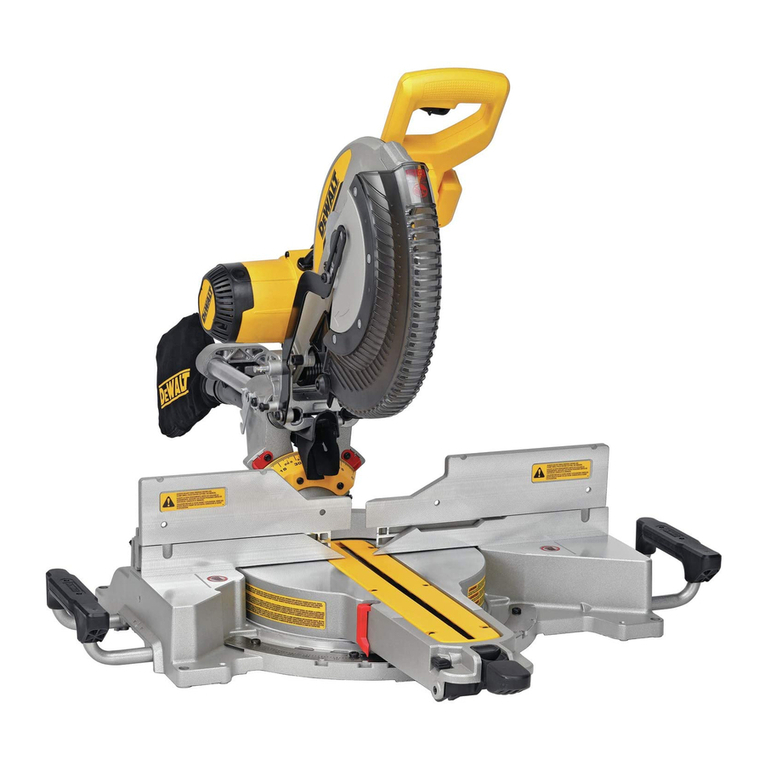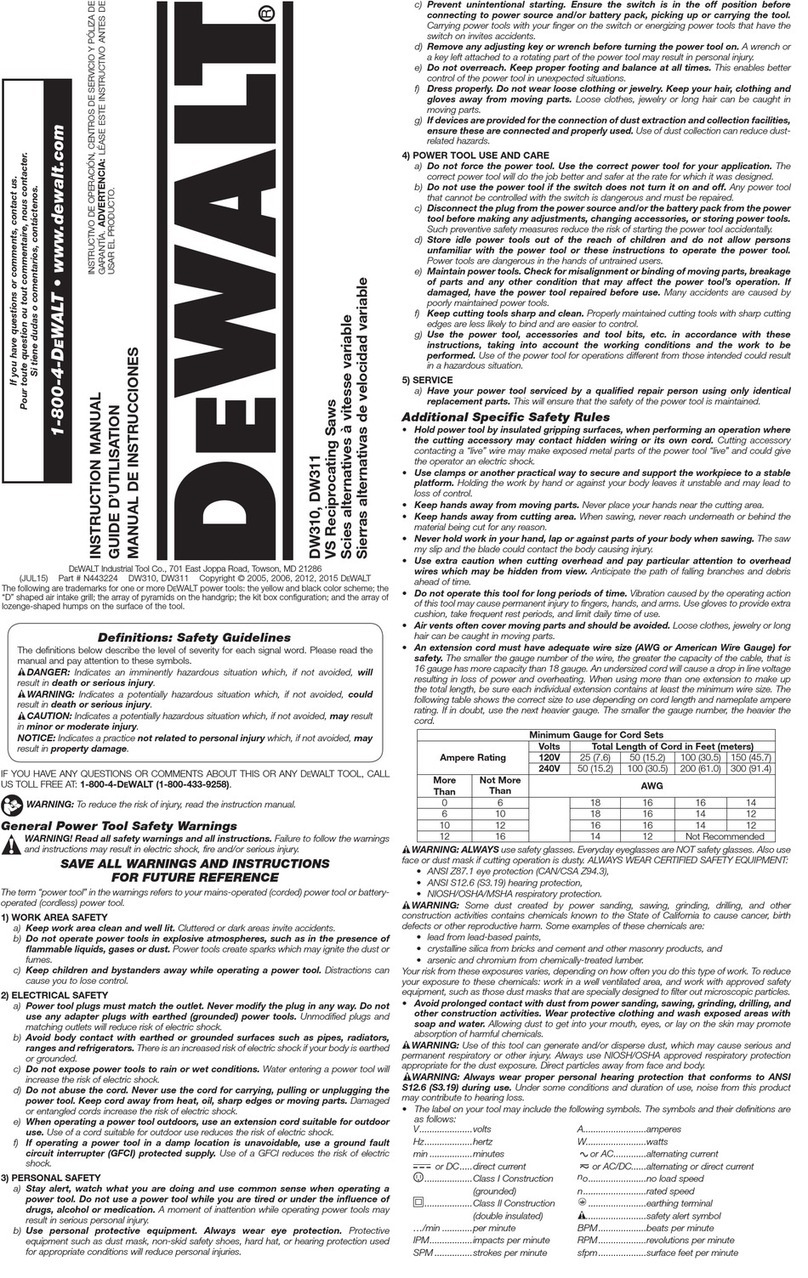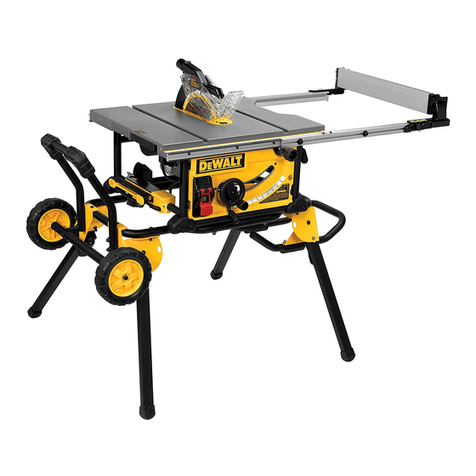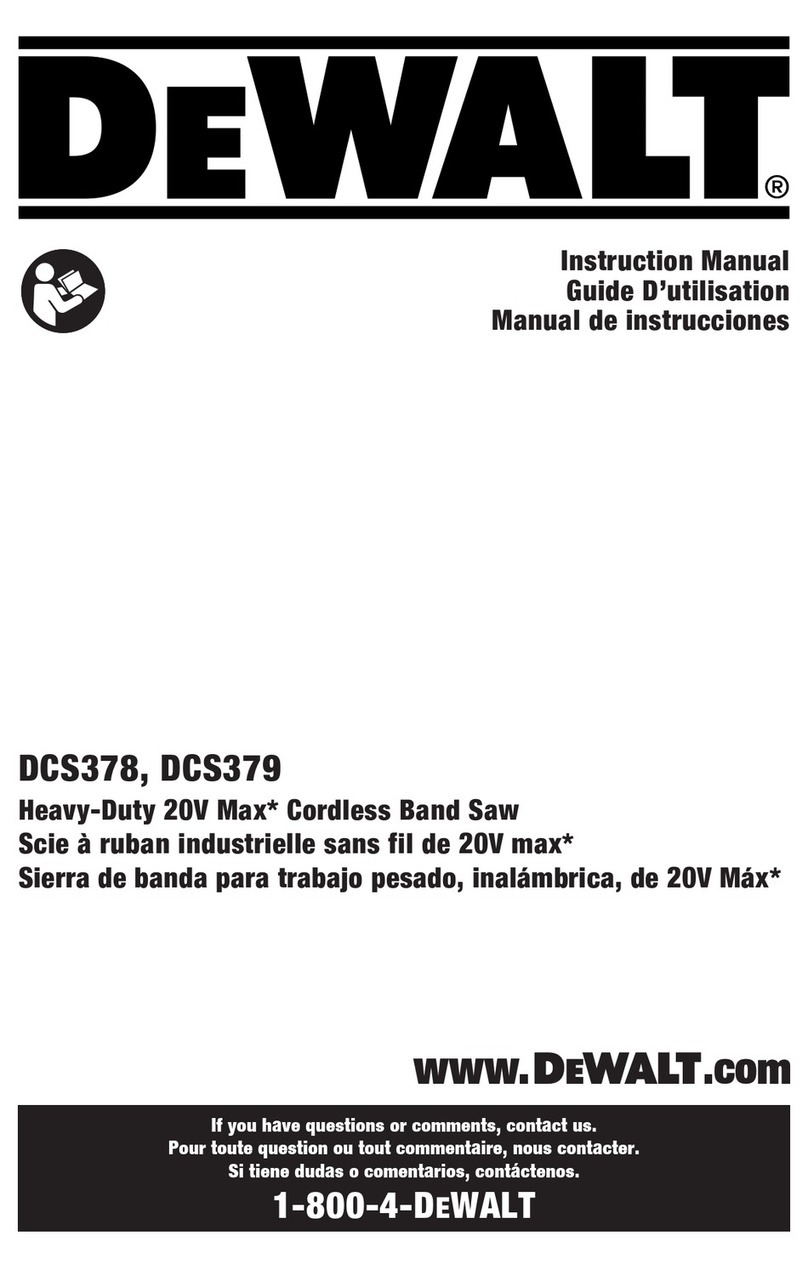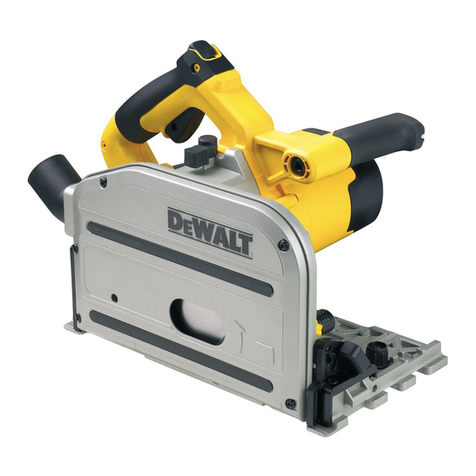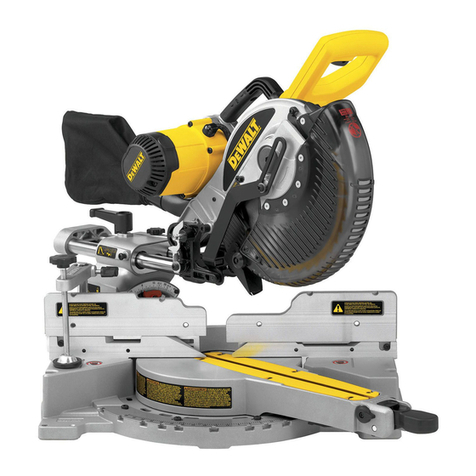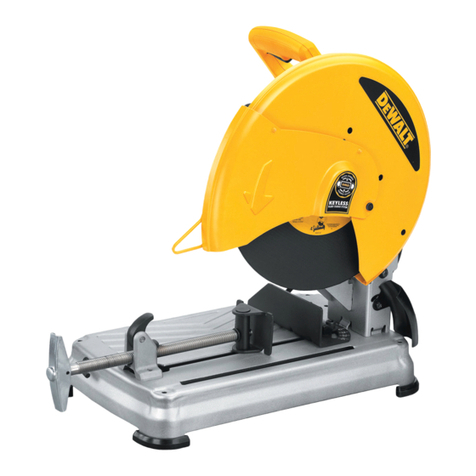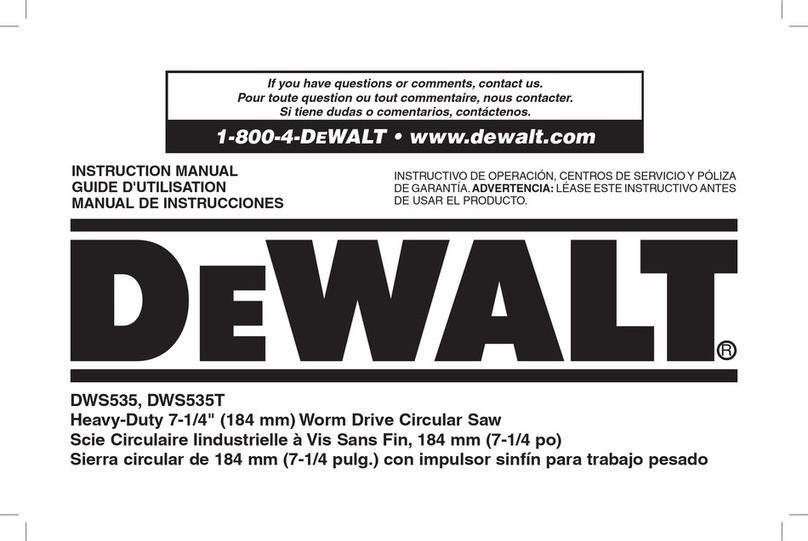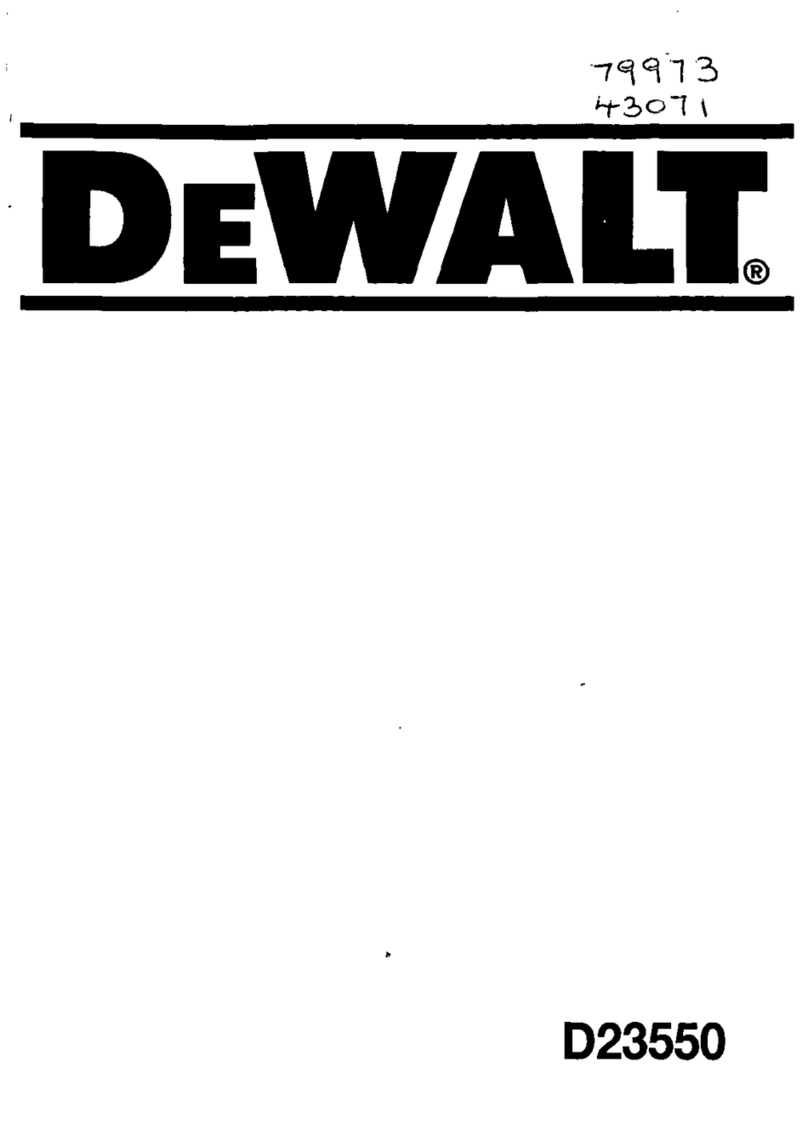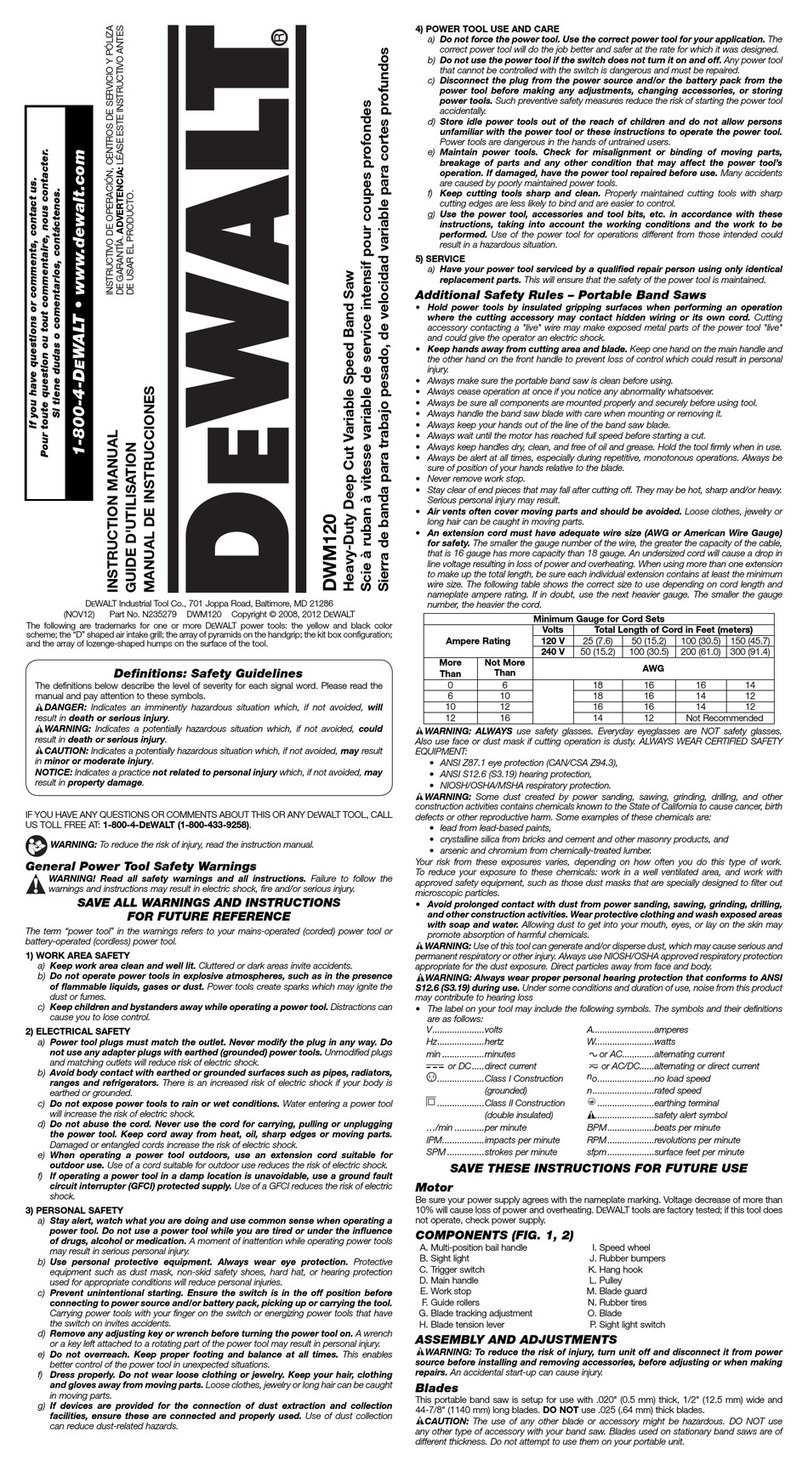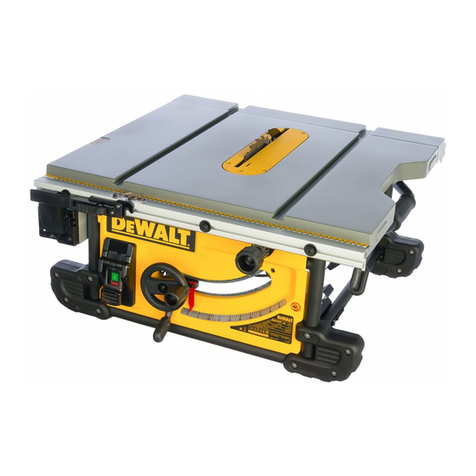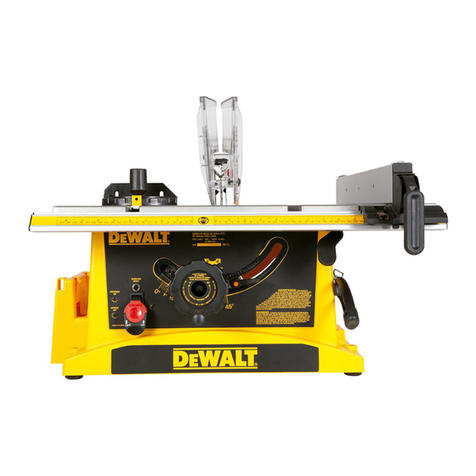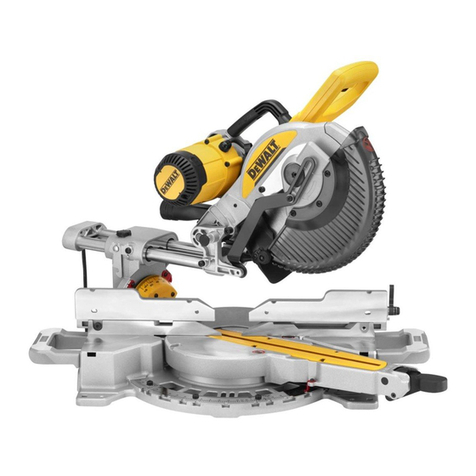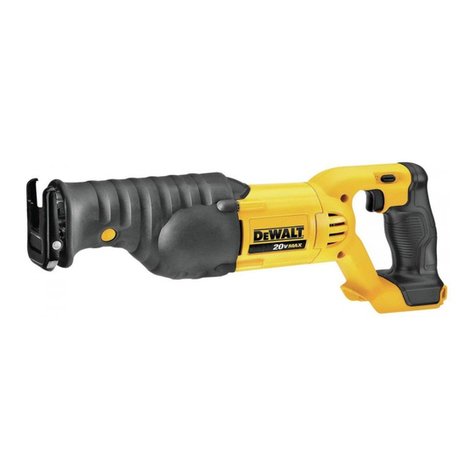Adjusting the bevel stop to 45°left
NOTE: Adjust the 45 ° bevel
angles only after performing the 0°
bevel angle adjustment and bevel F
pointer adjustment.
To adjust the left 45° bevel angle,
loosen the bevel lock handle (F) and
tilt the head to the left. Ifthe pointer R1(45°)
does not indicate exactly 45°, turn
the bevel stop screw (R1) until the
pointer reads 45°.
Toadjust the crown stop (33.85°) bevel angle, loosen the bevel
lock handle. When the saw is on the stop, if the pointer does not
indicate exactly 33.85 °, turn the bevel stop screw (R2) until the
pointer indicates 33.85 °.
FENCE ADJUSTMENT
WARNING: Disconnect the saw from the power supply,
turn off the machine and allow the blade to come to a com-
plete stop before raising the arm and prior to cleaning the
blade area, removing debris in the path of the blade,
before servicing or adjusting tool. A moving blade can
cause serious injury.
CAUTION: ALWAYS complete a dry K
run without power before making any \
cuts or damage to the fence may
OCCUi_
To Adjust the Sliding Fence
1. For normal use, loosen the knob
(K) one full turn to slide fence, then
tighten the knob securely. This will allow clearance
between the fence and the blade.
2. To provide maximum workpiece support when cutting
smaller pieces, loosen the knob (K) three full turns. The
fence will slide freely allowing the fence to move closer to
the blade. Tighten the knob securely.
NOTE: When beveling and mitering, it may, in rare circum-
stances, be necessary to remove the sliding fence. To remove
the fence, fully loosen the fence adjustment knob until the fence
is free to slide off. Reinstall the sliding fence and adjust properly
for workpiece support.
RAIL GUIDE ADJUSTMENT s H
Periodically check the rails for any \
play or clearance. The right rail
can be adjusted with the set
screw (S) shown on top of the
support housing. To reduce clear-
ance, rotate the set screw clock-
wise gradually while sliding the
saw head back and forth. Reduce
play while maintaining minimum
sliding force.
NOTE: The rail lock knob (H) must be loose to allow the saw
rails to slide.
KERF PLATE ADJUSTMENT
AWARNING: Disconnect the saw from
the power supply, turn off the machine
and allow the blade to come to a com-
plete stop before raising the arm and
prior to cleaning the blade area, remov-
ing debris in the path of the blade,
before servicing or adjusting tool A
moving blade can cause serious injury.
Do not use this saw without a kerf plate
installed. Replace a kerf plate when ff is worn or damaged.
To install anew kerr plate:
1. Remove the three screws holding each kerf plate in place.
2. Remove the ken<plates and clean the area beneath.
3. Install the new kerf plates.
4. Replace the screws.
To adjust the kerf plate for the desired blade:
1. Loosen but do not remove the three kerf plate screws.
2. Adjust the plates to fit closely to the teeth of the blade.
3. Tighten the 3 screws on each kerf plate.
Guard Actuation and Visibility
The blade guard on your saw
has been designed to automatically
raise when the arm is brought down
and to lower over the blade when the
arm is raised.
The guard can be raised by hand
when installing or removing saw
blades or for inspection of the saw.
NEVER RAISE THE BLADE GUARD
MANUALLY UNLESS THE SAW IS
TURNED OFR UNPLUG THE SAW BEFORE ANY CLEANING
OR ADJUSTMENTS. If the guard becomes dirty, clean with a
dry cloth or a water-dampened cloth.
ACAUTION: Do not use lubricants or cleaners, particularly
spray or aerosol cleaners, in the vicinity of the plastic guard. The
polycarbonate material used in the guard is subject to
deterioration by certain chemicals.
NOTE: Certain special cuts will require that you manually raise
the guard. See the section titled Cutting Large Material on
page 10.
The front section of the guard is Iouvered for visibility while
cutting. Although the louvers dramatically reduce flying
debris, they are openings in the guard and safety glasses
should be worn at all times when viewing through the louvers.
Automatic Electric Brake
Your saw is equipped with an automatic electric blade brake
which stops the saw blade within 5 seconds of trigger release.
This brake is not adjustable.
On occasion, there may be a delay between the trigger releas-
ing and brake engagement. On rare occasions, the brake may
not engage at all and the blade will coast to a stop.
If a delay or "skipping" occurs, turn the saw on and off 4 or 5
times. If the condition persists, have the tool serviced by an
authorized DEWALT service center or other qualified personnel.
Always be sure the blade has stopped before removing it from
the kerr. The brake is not a substitute for guards or for ensur-
ing your own safety by giving the saw your complete attention.
Brushes
WARNING: Disconnect the saw from the power supply,
turn off the machine and allow the blade to come to a com-
plete stop before raising the arm and prior to cleaning the
blade area, removing debris in the path of the blade,
before servicing or adjusting tool A moving blade can
cause serious injury,
Inspect carbon brushes regularly
by unplugging tool, removing the
motor end cap, lift the brush spring
and withdraw the brush assembly.
Keep brushes clean and sliding
freely in their guides. Always
replace a used brush in the same
orientation in the holder as it was
prior to its removal. Carbon brushes have varying symbols
stamped into their sides, and if the brush is worn down to
approximately 1/2 inch, the spring will no longer exert pres-
sure and brushes must be replaced. Use only identical
DEWALT brushes. Use of the correct grade of brush is essen-
tial for proper operation of electric brake. New brush assem-
blies are available at DEWALT service centers. The tool
should be allowed to "run in" (run at no load) for 10 minutes
before use to seat new brushes. The electric brake may be
erratic in operation until the brushes are properly seated
(worn in). Always replace the motor end cap after inspecting
or servicing the brushes.
While "running in" DO NOT TIE, TAPE, OR OTHERWISE
LOCK THE TRIGGER SWITCH ON. HOLD BY HAND ONLY.
OPERATION
Switch
To turn the saw on, depress the trig-
ger switch (D). To turn the tool off,
release the switch. There is no provi-
sion for locking the switch on. To lock
the saw off, place a padlock in the
hole provided in the trigger switch.
Cutting With Your Saw
NOTE: Although this saw will cut wood and many non-ferrous
materials, we limit our discussion to the cutting of wood. The
same guidelines apply to the other materials. DO NOT CUT
FERROUS (IRON AND STEEL) MATERIALS, MASONRY,
OR FIBER CEMENT PRODUCTS WITH THIS SAW. Do not
use any abrasive blades.
